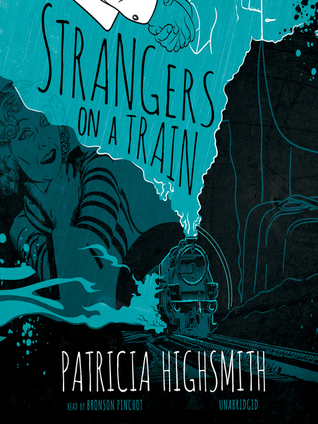 Strangers on a Train by Patricia Highsmith
Strangers on a Train by Patricia Highsmith Narrator: Bronson Pinchot
Published by Blackstone Audio on July 7, 2015
Source: Library
Genres: Classic, Crime Fiction
Length: 9 hrs 41 mins
Format: Audiobook
Purchase at Bookshop.org or Purchase at Amazon
Add on Goodreads

In Patricia Highsmith's debut novel, we encounter Guy Haines and Charles Anthony Bruno, passengers on the same train. But while Guy is a successful architect in the midst of a divorce, Bruno turns out to be a sadistic psychopath who manipulates Guy into swapping murders with him. As Bruno carries out his twisted plan, Guy is trapped in Highsmith's perilous world - where, under the right circumstances, anybody is capable of murder.
The inspiration for Alfred Hitchcock's classic 1951 film, Strangers on a Train launched Highsmith on a prolific career of noir fiction and proved her mastery of depicting the unsettling forces that tremble beneath the surface of everyday contemporary life.
There are some classics that I wonder why it has taken me so long to get around to. Strangers on a Train by Patricia Highsmith is one of those. It’s a dark, psychological thriller that shows anyone can be capable of murder, given the right, or wrong, circumstances. As the blurb states, Guy Haines and Charles Anthony Bruno meet on a train. Guy tells Bruno the story of his problems with his wife, who he wants to divorce but who is putting up obstacles left and right, even though she’s pregnant with another man’s child. Bruno, meanwhile, tells Guy about his meany dad and suggests they trade murders. Guy declines, he’s basically a good guy after all, but he fails to realize that Bruno is an alcoholic psychopath, who, after killing Guy’s wife, expects Guy to follow through with his end of the deal. That’s where the bulk of the novel, and tension lies. Bruno is manipulative and black-mailing; Guy never knows who he’s going to tell or where he’s going to turn up. The plot itself is a bit predictable now, but that doesn’t lessen its tautness. And then as the guilt wear on both men, they become even more connected, in a love (or fascination) / hate kind of way.
I wish I had read this instead of listening to the audio. The narrator did a good job, don’t get me wrong, I just feel like he made Bruno very whiny. Yes, he was definitely a momma’s boy and a drunk, but the nuances were missing. He was more a caricature than I think he would have been in print. Without the childish intonations, I think the very real danger he presented to Guy would have been more palpable. But he was also infatuated with Guy and truly wanted to be near him, spend time with, while his mere presence drives Guy further into his dark pit.
On the other hand, it’s not Bruno’s development that interests us. How can Guy, a respected man in his field, intelligent, with all of his resources, how could he be pushed to murder? And not just murder, but the murder of a man he doesn’t know? Guy needs a back bone. I was a bit disappointed with the ending too, even if it may have been inevitable.
I’m going to try to watch Hitchcock’s movie this weekend. I’ve never seen it and I’m interested in how it compares to the novel.

I have always been interested in this author but I would rather read her work than listen to it!
That’s what I should have done.
Yep…
Great review! Did you listen to the audio version read by Bronson Pinchot? Because I thought he was pretty perfect! But narrators are very much a taste thing – what works for one reader might not work for another.
Like you I liked but didn’t love this book – it was hard to understand just why Guy went as far as he did. So frustrating!
It was the version by Bronson Pinchot, but like you said the same narrator won’t necessarily work for different readers. I actually think it’s the first book I’ve listened to read by him.
I’ve never read anything at all by Highsmith – shame on me. This sounds terrific.
This is the first I’ve read by her. I’d like to read her Tom Ripley books too.
I watched the movie years ago and liked it. Not sure why I never added this to my reading list. This would be perfect for The Classics Club!
We didn’t get to watch the movie this weekend – maybe next weekend. My Saturday evening, when I was hoping to watch it, got taken over by a Praise team practice.
I must try to track down this author. The book sounds good.
It’s definitely worth reading, even if I didn’t love it.
I’ve never read the book but I loved the movie.
I still haven’t watched it. Maybe next weekend.
That is my main issue with audio books…sometimes the interpretation the reader is taking is different than what you would’ve taken.
Once in a while, a narrator just doesn’t quite work me. It doesn’t happen often, and maybe it has something to do with whether I connect the person to something other than book narration, like Bronson Pinchot and Perfect Strangers or Wil Wheaton and Big Bang Theory and TableTop.
[…] year I have to add Strangers on a Train to the list. I read the book in February and then watched the Hitchcock movie shortly after. […]
[…] 6. A classic crime story – Strangers on a Train by Patricia Highsmith […]